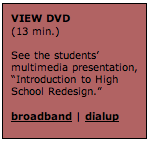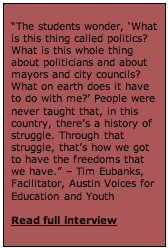
Student Activists Use Video to Demand a Voice in School Redesign
by Abe Louise Young
AUSTIN—With a video camera to her eye, Charlie Rose, 17, moves through a buzzing high school hallway at lunchtime. She poses the same question to each person she stops: “What do you think of high school redesign?”
Quizzical looks and humorous replies confirm her suspicions: Not a single student here has heard of the concept. her discovery is significant, as Austin Independent School District will soon redesign all eleven of its comprehensive high schools.
 Charlie Rose, Alice Geaccone, Paula Rideau, and four other youth are out to challege a widespread lack of knowledge about the plan among public school students. They work as Youth Mobilizers with Austin Voices for Education and Youth. During the school day, they study social change movements, and in the afternoon, they work as organizers, leading students to exercise their rights to a quality education. This spring, the Youth Mobilizers documented their efforts in a multimedia presentation called "Introduction to High School Redesign."
Charlie Rose, Alice Geaccone, Paula Rideau, and four other youth are out to challege a widespread lack of knowledge about the plan among public school students. They work as Youth Mobilizers with Austin Voices for Education and Youth. During the school day, they study social change movements, and in the afternoon, they work as organizers, leading students to exercise their rights to a quality education. This spring, the Youth Mobilizers documented their efforts in a multimedia presentation called "Introduction to High School Redesign."
Entirely student-made, the presentation combines research,
videography, still photography, text and music to set out concrete suggestions for change. It’s a landmark in defining what young people want—and don’t want— from their high schools in Austin.
Naming Their Needs
Johnnie Ellison, 21, sums up the purpose of their work: “Really, the things we need are different from what people up top think we need. We should be part of these conversations from the start.”
To begin, the team researched the redesign process and pored over every document. They decided that the concept “Respect” needed to be added to the school district’s redesign motto of “Rigor, Relevance, Relationships, and Results.”
They surveyed other students—and parents—about their educational desires, and came up with fresh suggestions like anger-management and anti-racism trainings in school.
"I am concerned with the number of students who think joining the military is their only option. Schools need to do a better job showing kids that they can go on to higher education without signing their rights away,” says student Will Martin.
The mobilizers attended long school board meetings, asked questions, and debated with adults. Not content with the official offerings, they decided to host meetings of their own. When a school board election next took place, the Youth Mobilizers held a candidates forum and queried candidates on their knowledge of student issues.
Visiting high schools around the city, the team took a series of black-and-white photographs. From bathroom stalls without doors to broken bookshelves and computers, the images speak clearly of environments in distress.
Rallying the Next Generation of Leaders
 Back on their own turf at Austin’s Garza High School, the Youth Mobilizers sit at a round table to plan the next move. The walls are papered with pictures of civil rights leaders and inspiring quotes, and a vibrant Aztec mural graces the stairway leading to the classroom. Perhaps the positive climate at their own school inspires the students to want the same nurturance for everyone.
Back on their own turf at Austin’s Garza High School, the Youth Mobilizers sit at a round table to plan the next move. The walls are papered with pictures of civil rights leaders and inspiring quotes, and a vibrant Aztec mural graces the stairway leading to the classroom. Perhaps the positive climate at their own school inspires the students to want the same nurturance for everyone.
Facilitator Tim Eubanks describes the learning process that Youth Mobilizers undergo: “We show students examples of how students have engaged in acts of civil disobedience in the past. The efforts of Rosa Parks. The efforts of the Student Nonviolent Coordinating Committee…. It’s tying the idea of civil disobedience in with the idea of social movement and electoral politics.” When Youth Mobilizers graduate, at least at third stay on as trainers for the next group of young activists.
The Youth Mobilizers release their multimedia presentation this September—but their work does not end there. They’ll be broadcasting the piece on a large screen in a public plaza soon, when they lead a Stand Up rally—part of a national campaign to protest the high school drop-out rate and reclaim education.
On September 9, 2006, young people from throughout Central Texas gathered to share their feelings, hopes and frustrations about their educational system. Through hip-hop, spoken word, theatre, and poetry, youth spoke from the heart about what they want and need to stay in school and graduate. At the same time, they learned about redesign and participated in a survey from the Garza team, whose next aim is to survey 400 teenagers.
Whether or not the Austin school district takes their suggestions to heart, there’s no doubt that these students have influenced the redesign process. The Youth Mobilizers of Garza Independence High School don’t sit around waiting for anyone to request their input—they are too busy building the world they dream of.
Click below to:
Watch the documentary video “Introduction to High School Redesign" [broadband] [dialup]
Read an interview with facilitator Tim Eubanks from Austin Voices for Education and Youth
Download a PDF of “Tuesday Seminars: Lessons for Life,” a 19-page curriculum aimed at helping young people understand the struggle behind the rights we all hold dear.


